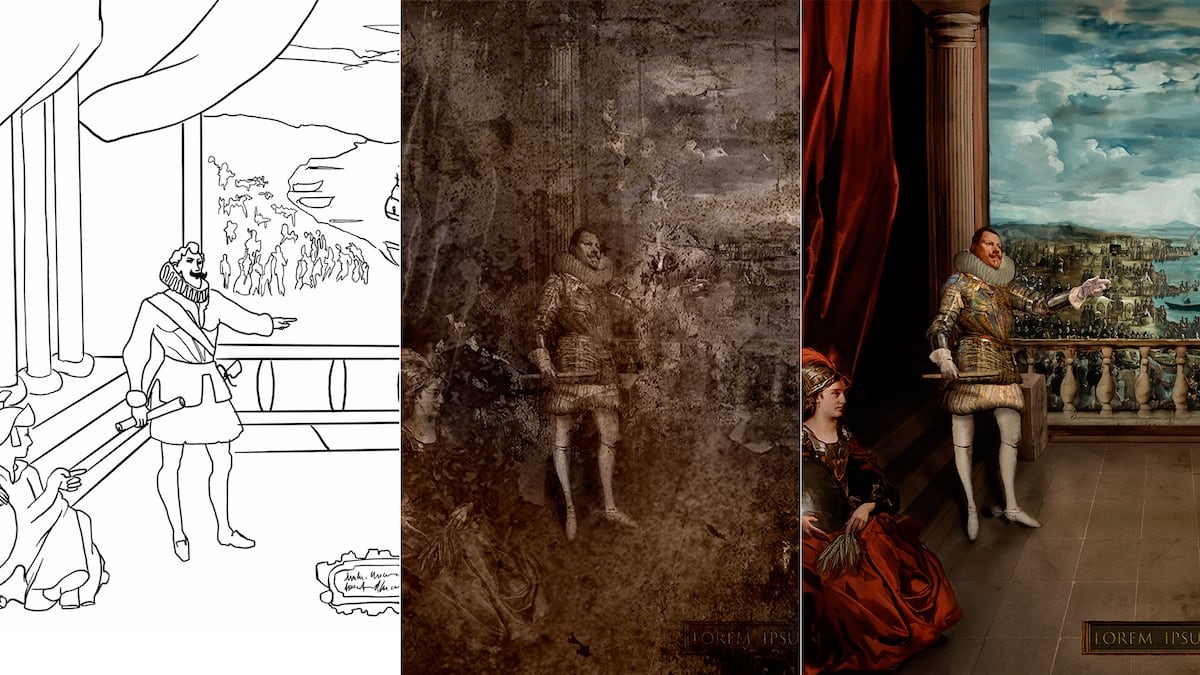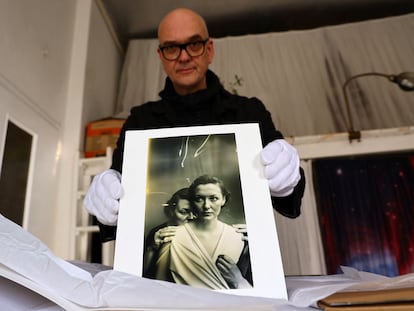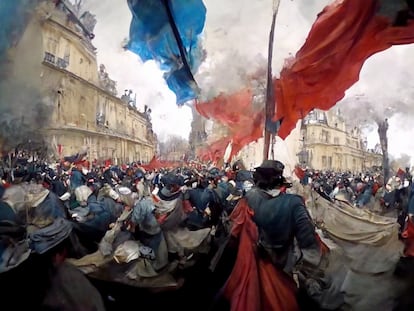AI recreates Velázquez’s ‘Expulsion of the Moriscos’ lost to flames centuries ago
Artist Fernando Sánchez Castillo used technology and history to reconstruct the painting destroyed in an 18th-century fire

In less than ten years, it will be three centuries since a significant event changed the course of Spain’s history. On Christmas Eve in 1734, a fire began in Royal Alcázar of Madrid (now the site of the Royal Palace) and raged for four days, destroying around 500 works of art. The thought of lost paintings by renowned artists like Ribera, Titian, El Greco, Giordano, Raphael, Rubens, Leonardo (probably a copy), Tintoretto and Velázquez was truly heartbreaking for art lovers then and now. Fortunately, Diego Velázquez’s Las Meninas was rescued by throwing it out of a window, while some other large canvases were cut from their frames and saved. Historian and former Prado Museum director Alfonso Pérez Sánchez estimated that 1,308 paintings survived the catastrophic fire. But Velázquez’s Expulsion of the Moriscos (1627) did not.
Nearly 300 years later, artist Fernando Sánchez Castillo used artificial intelligence (AI) software to recreate the lost Velázquez. The outcome is a four-minute video that begins with what looks like a murky, charred canvas. Sánchez didn’t start from scratch — AI technology needs to be fed data. The video slowly transforms into a clear painting of King Felipe III ordering the expulsion of the Moors from Spain, when around 250,000 people were forced out between 1609 and 1614. “It’s a stark example of the new religious fanaticism in Spain — the Black Legend. King Felipe III violated all principles of good governance by expelling a hardworking people,” wrote historian John Elliott. Sánchez says Velázquez was the first to create a painting that evoked “the two faces of Spain and the Islamophobia of the time.”
Generative AI needs input to get started. Luckily, shortly before its destruction, a historian and artist named Antonio Palomino (1655-1726) penned a description of the Velázquez painting. “King Felipe III is depicted holding a scepter, pointing to a group of sorrowful men, women and children being led away by soldiers. In the distance are wagons and a Navy ship, with smaller boats waiting to transport all the people. Spain is depicted in the Roman style as a majestic matron with a shield, holding darts in her right hand and wheat sheaves in her left. An inscription [in Latin] is at her feet on a plinth.”
These were important and fortuitous words for Sánchez’s task, but he would need more good luck to be successful. He needed something similar to the real image to feed the AI program. In 1988, Spanish art expert William B. Jordan discovered a black and white illustration in a catalog from the Philips auction house in London. The untitled painting, labeled as “Bust of a knight with a high collar,” was attributed to an artist from Flemish painter Justus Sustermans’s circle. The small canvas, which had been altered by gluing another piece to it, depicted King Felipe III. Upon restoration, both the Kimbell Art Museum in Texas and Madrid’s Prado Museum confirmed that it was a preliminary sketch by Velázquez for his Expulsion of the Moriscos painting. William B. Jordan acquired that small canvas and donated it to the Prado in 2016 through the American Friends of the Prado Museum organization.
As AI input, Sánchez also used the paintings from a competition sponsored by King Felipe IV in 1627. The king ordered Velázquez and his jealous rivals from the royal court to each create a large painting depicting the expulsion of the Moors. The contenders were Vicente Carducho (1563-1638), Eugenio Cajés (1577-1634) and Angelo Nardi (1584-1660), an artist trained in Italy. The king appointed Dominican Friar Juan Bautista Maíno (1581-1649) and the architect and painter Giovanni Battista Crescenzi (1577-1635) as independent judges. All the competing artists presented draft sketches, most likely in oil. Velázquez won, and proved that he knew how to paint more than heads, as his detractors claimed. After his victory, Velázquez was appointed King Felipe IV’s official court painter.
Back to the present. Armed with Palomino’s text and the preliminary sketch that Velázquez would use as a starting point for his larger painting, Sánchez turned next to Paula García, a student at the Complutense University of Madrid who wrote her thesis on AI applied to contemporary sculpture. Using a blend of history and technology, the two spent over 100 hours reconstructing Velázquez’s Expulsion of the Moriscos. They say 80% of the result is derived from artistic creations and 20% is due to AI. “People always have this natural suspicion about artificial intelligence,” said Sánchez.
AI contributes a great deal but also makes mistakes. Sánchez and García started working with MidJourney, a generative AI program that transforms words into images. These words or prompts provide text and image instructions to an AI model that uses them to generate coherent responses. “The more precise the prompt, the better it works. If you’re vague, like saying ‘allegory of Spain’ for our painting, you’ll see Spanish flags pop up on the screen. It’s a time-consuming job that requires patience. You move forward, go back, check internet images, then move forward again,” said García, who now in specializes in video game design. “The most difficult parts were the steps and curtains in the background, and the hands. But above all, the architecture was the hardest part.” Once the individual elements of the painting had been created, they all had to fit together. For this, they used the latest version of Adobe Photoshop that incorporates an artificial intelligence feature called “generative filling.” It enables various images to be joined together seamlessly. García likens it to “having an army of apprentices.”
Spain’s Ministry of Culture has placed limits on “technological art” and pledges not to recognize or commission AI-generated works. Maybe it’s all a matter of percentages. The European Fine Art Fair (TEFAF) — the world’s foremost art, antiques and design fair held annually in Maastricht (the Netherlands) — prohibits exhibiting pieces with more than 30% restoration. That policy excludes pieces like Salvator Mundi, a painting attributed in whole or in part to Leonardo da Vinci. It was rediscovered and restored in 2011–2012, and then sold for $450 million. A matter of intelligence, not artificial.
Sign up for our weekly newsletter to get more English-language news coverage from EL PAÍS USA Edition










































